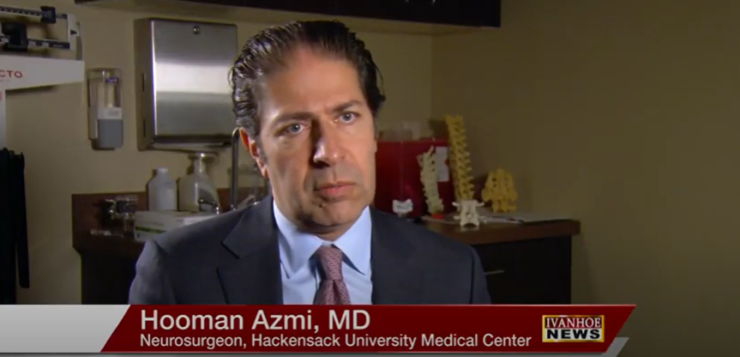Hooman Azmi, MD, FAANS, Division Director for Functional and Restorative Neurosurgery in the Department of Surgery at Hackensack Meridian Health University Medical Center, talks about Parkinson’s and what has changed.
Can you give a quick overview of what happens in a patient’s body with Parkinson’s?
AZMI: Parkinson’s disease, in general, is a disorder that results from the brain’s inability to make neurotransmitter called dopamine. So, a lot of the functioning of the brain is affected. It is most pronounced in movement. Sometimes we see patients that have tremors, and sometimes they’re a little bit slower to move or they’re stiff. The pattern of their movement is notable. But it also affects many other brain functions such as sleep, mood, and cognition. It’s an all-encompassing disorder.
Can you briefly talk about the treatment options?
AZMI: The mainstay treatment for Parkinson’s is replacement of dopamine, the substance that is depleted in the brain. The medications we have either replace it or mimic it or prevent the breakdown of what’s available in the brain. This is, in general, how we treat the disorder. There are also surgical options when medications are not working or not working properly. Over time, that can happen to some people and the medications can become erratic. The efficacy of the medicine could be short lived and doesn’t kick in as it used to. This is when we start to think about surgery, which is called deep brain stimulation. It’s a surgery where we implant a pacemaker into the brain and then we control the pacemaker with certain settings. This helps reduce the symptoms of the patient.
How many people in the United States are impacted by Parkinson’s, whether mild or severe?
AZMI: Somewhere between 1 to 2 million people in the U.S. are affected by Parkinson’s disease.
You and your colleagues looked at how to manage Parkinson’s in a hospital. Why is that important?
AZMI: It’s a big problem for someone with Parkinson’s disease when they come into the hospital. Especially when Parkinson’s is more advanced, after a period of time patients become very dependent on their medication and on the timing of the medication. It’s really a challenge to get them on a good regimen where they’re able to get the benefits of the medicine without the side effects. And often, after someone’s been on Parkinson’s medicines for a while, they go through what we call motor fluctuations where the medications can work for a period and then stop working and the day becomes these ups and downs with these fluctuations. The job of the neurologist who treats Parkinson’s is to make sure that they put patients on a regimen that minimizes those motor fluctuations and minimizes side effects from the medicine. This timing becomes complicated. Patients sometimes take their medication every three hours, sometimes every two hours. If they start at 6:15 in the morning and change to 6:30, the whole day is off. Their life revolves around this medication regimen. When patients who need to take their medication in such strict ways go into the hospital, they often do not receive their medicine in a timely manner because hospitals in general are not set up for this, and they can have complications. In addition, most patients with Parkinson’s go to the hospital for non-Parkinson’s symptoms like back pain, abdominal pain, heart attack, or elective surgeries. The Parkinson’s unfortunately gets kind of lost in the shuffle. And, we don’t put the medication orders in as they take it at their home. This results in patients missing their medication. There’s plenty of evidence to show that when patients with Parkinson’s miss their medications by 30 or even 15 minutes, it can result in a major problem for them, which in turn increases their complications and risks in the hospital. So, it’s critical to pay attention to this group of patients when they’re coming into the hospital.
Maybe it’s an assumption on the patient’s part that if you’re going into a medical setting, your needs will be met. And, that includes the Parkinson’s patients needing medication. Is that not always the case?
AZMI: It should be. When we go to a hospital, we should expect excellent care, and that should include knowing what disorders we have and knowing what medications we’re on. But unfortunately, it doesn’t always happen. It’s not because the care isn’t good. It’s just because there’s so much going on and people don’t know enough about these subtle issues with Parkinson’s that can affect someone with the disorder in a negative fashion. The Parkinson’s Foundation has put out a campaign called Aware In Care to address this issue. Patients are issued a kit containing useful tools and information to help them during a hospital stay. It also includes a notebook for them to list their medications, dosing, timing, and any other pertinent information that hospitalists should be aware of. There are also educational postcards explaining Parkinson’s, the symptoms of Parkinson’s, the medications for Parkinson’s, and what medications are contraindicated in patients with Parkinson’s. It’s an educational packet for the hospital. It behooves us as health care providers to familiarize ourselves with the care of these patients because whether we are a surgeon, doctor, nurse, or physical therapist, our job is to take care of patients, and at some point in our career we will treat a patient with Parkinson’s.
Can you describe what kind of changes you made and whether this could be a gold standard for other hospitals?
AZMI: What we try to focus on is to elevate the care across the hospital for patients with Parkinson’s disease. The most important thing is to make sure that medicines are ordered in the way that the patient takes at home, and not the default timing that is standard in the hospital. We actually ask the patient, “What time do you take this medicine?” Then, we record the times and reflect that in the orders so that the patient gets their medicine on time. The other thing that’s very important is to make sure that patients do not get contraindicated medications. Some medicines that are commonly used in the hospital should not be used for Parkinson’s patients. Also, it is not a good idea to substitute Parkinson’s medications. Patients are very sensitive to that, particularly if they’ve been taking a certain medication for a long time. And, if they’re in the later stages of Parkinson’s, they’re dependent on the brand they use. We must make sure that hospital pharmacies stock these things. We developed this protocol by first identifying Parkinson’s patients who are admitted to the hospital. We also supply many tools to educate everyone who meets those patients – nurses, physical therapists, etc. – as to the importance of these things. We’re also tracking how many of the medications for Parkinson’s disease are being ordered in patient specific ways. That’s what we put into the electronic medical records system. And we track how many times these patients get contraindicated medications. We went to the joint commission, and based on our protocol, we were able to get special certification for care of patients with Parkinson’s disease. Hackensack is the first acute care hospital in the country to have received that certification. We’re very proud of that. We do hope that other hospitals start to pay attention to these important issues in one way or another.
Is the book you wrote tailored to this issue? Is it directed more toward the hospital or is it towards the general patient population with Parkinson’s?
AZMI: I’ve had patients that have read the book and say that its eye opening for them because of the point you brought up. You would expect when you go into the hospital that everything is taken care of. But they do see that there could be some holes. Therefore, they must be good advocates for themselves. The book is really geared towards health care providers- nurses, physical therapists, doctors, or anyone that comes across someone with Parkinson’s disease in the hospital. It explains all of the important issues that we have discussed.
What are the top three things you would tell family and friends who have loved ones with Parkinson’s that they would need to know if they go to the hospital?
AZMI: It’s very important to be advocates for yourself and your loved one. Do not assume that things are going to happen the way that you would like to in the hospital. Speak up and tell people if you’re not happy with what’s happening. Bring the medications in the original bottles to the hospital and know the timing of these medications. Make sure that you do use the Aware in Care kit. It’s an excellent resource for patients and their families.
END OF INTERVIEW
This information is intended for additional research purposes only. It is not to be used as a prescription or advice from Ivanhoe Broadcast News, Inc. or any medical professional interviewed. Ivanhoe Broadcast News, Inc. assumes no responsibility for the depth or accuracy of physician statements. Procedures or medicines apply to different people and medical factors; always consult your physician on medical matters.
If you would like more information, please contact:
Mara Quigley, Account Executive
661-255-8283
Sign up for a free weekly e-mail on Medical Breakthroughs called First to Know by clicking here




